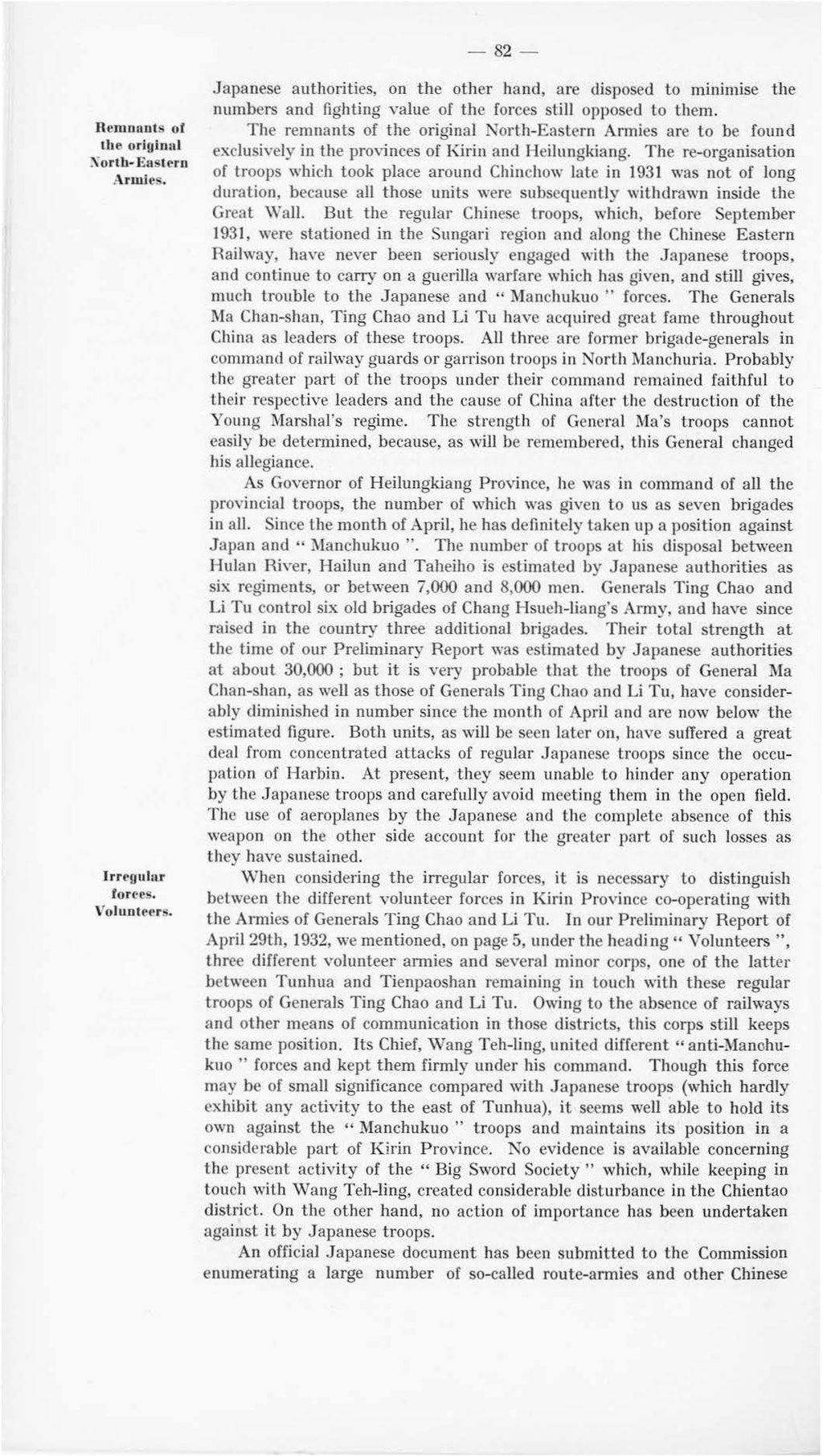—82—
Japanese authorities, on the other hand, are disposed to minimise the numbers and fighting value of the forces still opposed to them.
Remnants of the original North-Eastern Armies.The remnants of the original North-Eastern Armies are to be found exclusively in the provinces of Kirin and Heilungkiang. The re-organisation of troops which took place around Chinchow late in 1931 was not of long duration, because all those units were subsequently withdrawn inside the Great Wall. But the regular Chinese troops, which, before September 1931, were stationed in the Sungari region and along the Chinese Eastern Railway, have never been seriously engaged with the Japanese troops, and continue to carry on a guerilla warfare which has given, and still gives, much trouble to the Japanese and "Manchukuo" forces. The Generals Ma Chan-shan, Ting Chao and Li Tu have acquired great fame throughout China as leaders of these troops. All three are former brigade-generals in command of railway guards or garrison troops in North Manchuria. Probably the greater part of the troops under their command remained faithful to their respective leaders and the cause of China after the destruction of the Young Marshal's regime. The strength of General Ma's troops cannot easily be determined, because, as will be remembered, this General changed his allegiance.
As Governor of Heilungkiang Province, he was in command of all the provincial troops, the number of which was given to us as seven brigades in all. Since the month of April, he has definitely taken up a position against Japan and "Manchukuo". The number of troops at his disposal between Hulan River, Hailun and Taheiho is estimated by Japanese authorities as six regiments, or between 7,000 and 8,000 men. Generals Ting Chao and Li Tu control six old brigades of Chang Hsueh-liang's Army, and have since raised in the country three additional brigades. Their total strength at the time of our Preliminary Report was estimated by Japanese authorities at about 30,000; but it is very probable that the troops of General Ma Chan-shan, as well as those of Generals Ting Chao and Li Tu, have considerably diminished in number since the month of April and are now below the estimated figure. Both units, as will be seen later on, have suffered a great deal from concentrated attacks of regular Japanese troops since the occupation of Harbin. At present, they seem unable to hinder any operation by the Japanese troops and carefully avoid meeting them in the open field. The use of aeroplanes by the Japanese and the complete absence of this weapon on the other side account for the greater part of such losses as they have sustained.
Irregular forces. Volunteers.When considering the irregular forces, it is necessary to distinguish between the different volunteer forces in Kirin Province co-operating with the Armies of Generals Ting Chao and Li Tu. In our Preliminary Report of April 29th, 1932, we mentioned, on page 5, under the heading "Volunteers", three different volunteer armies and several minor corps, one of the latter between Tunhua and Tienpaoshan remaining in touch with these regular troops of Generals Ting Chao and Li Tu. Owing to the absence of railways and other means of communication in those districts, this corps still keeps the same position. Its Chief, Wang Teh-ling, united different "anti-Manchukuo" forces and kept them firmly under his command. Though this force may be of small significance compared with Japanese troops (which hardly exhibit any activity to the east of Tunhua), it seems well able to hold its own against the "Manchukuo" troops and maintains its position in a considerable part of Kirin Province. No evidence is available concerning the present activity of the "Big Sword Society" which, while keeping in touch with Wang Teh-ling, created considerable disturbance in the Chientao district. On the other hand, no action of importance has been undertaken against it by Japanese troops.
An official Japanese document has been submitted to the Commission enumerating a large number of so-called route-armies and other Chinese